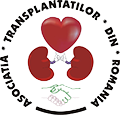
Association of Transplanted Patients from Romania
At the Introduction of Molecular Biology techniques in Transplant Immunology, instead of the current text, insert the text below and only the conclusions remain.Next-generation HLA DNA sequencing NGS versus Oxford Nanopore technology to improve donor-recipient immunogenetics (2023) Donor sequencing through Nanopore technology will improve and make it possible to obtain results in only 4 hours compared to NGS where results can be given in 6 days.
Long-term international scientific collaborations
- December 1999 – Anti-viral therapy? in chronic hepatitis B and C: patient selection, therapeutic regimens, clinical, paraclinical and histopathological parameters that are followed in the evolution of the viral infection – collaboration carried out in January at the Institute for the Study of the Liver, Kaplan, Rehovot, Israel Dr. Yoav Lurie.
- February 2000 – Incidence of hepatocellular carcinoma after interferon therapy in patients with chronic hepatitis B and C. Sequencing of HCV and HBV, with the study of HBV and HCV mutations in Romanian patients. Cloning studies of these viruses. Molecular biology techniques for the detection of HCV RNA and HBV DNA in serum and liver tissue. Research and clinical internship – Hepatology – Virology between 20.01-31.03.2000, carried out at the Royal Free Hospital, University College of London, with Dr. Tim Harrison and Prof. Geofrey Dusheiko. ‘Core Promoter Mutations in Patients with Chronic hepatitis B and Hepatocellular Carcinoma in Bucharest, Romania research project with the collaboration of Dr. Tim Harrison.
- July 2002 – Collaboration with The Anthony Nolan Bone Marrow Trust, Royal Free Hospital, Hampstead, London, UK, with Joyce Beo PhD, John O’Shea in the field of Bone Marrow Transplantation.
- June 2003 – Collaboration with the Immunogenetics Center of the National Medical Center, from Budapest, Hungary – Prof. Gyozo Petranyi – within the bilateral marrow transplant program. Creation of the national register of marrow donors in the Fundeni Clinical Institute.
- May 2004 – Collaboration with the Immunology and Histocompatibility Center “Evangelismos” Hospital, Athens, Greece – Dr. Chryssa Papasteriades, EFI responsible for the 8th European region, of which Romania is also a part.
- October 2004 – collaboration with Prof. Ilias Doxiadis from the Eurotransplant Reference Laboratory in Leiden, Holland in the field of Histocompatibility; dialogue regarding the accreditation process of Romanian Histocompatibility laboratories.
- October 2005 – Collaboration with “Central Laboratory of Clinical Immunology – University Hospital Alexandrovska” from Bulgaria – Prof. Dr. Elisaveta Naumova, Dr. Milena Ivanova, in the field of HLA polymorphism and cytokine genes in the elderly, results presented at the 14th meeting IHIW of the European Federation of Immunogenetics during November 29 – December 3, 2005, Melbourne, Australia.
- November 2005 – Collaboration with UKNEQAS (United Kindom National External Quality Assessment Schemes) – professional association of external quality control, from Great Britain, in the field of medical education and quality control in the field of Molecular Biology, Immunogenetics, Transplant Immunology, Tumor Immunology and Virology.
